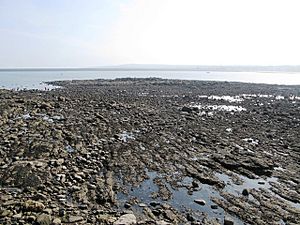Black Middens facts for kids
The Black Middens is a group of rocks, like a natural reef, located at the mouth of the River Tyne in North East England. It's well-known because it can be very dangerous for ships.
Why the Black Middens are Dangerous
The Black Middens are especially risky because they are mostly hidden underwater when the tide is high. Also, shifting sandbars often form around them, making the area even more unpredictable.
Many ships have crashed onto the Black Middens and been wrecked over the years. For example, during three days of bad storms in 1864, five ships were destroyed here. This led to a great loss of life, even though it happened close to the shore.
To help prevent such terrible accidents, the Lights of North Shields were built in 1536. King Henry VIII ordered them to be built. These lights helped guide sailors safely into the river. The first Volunteer Life Brigade was also started in Tynemouth in 1864. Their job was to rescue sailors who found themselves in danger near the rocks.
Even in more recent times, ships have run aground on the Black Middens. This happened as late as the 1970s.
What's in a Name?
The word Midden comes from Scandinavia. It's a common word in some dialects in North East England. It means a pile or dump of household waste.
There's a local story about how the Black Middens got their name. Legend says that the devil himself threw these rocks into the Tyne. He supposedly did this to mess up the rich trade of coal that was shipped from Newcastle upon Tyne.
A Look Back in Time
For a long time, there was a busy fishery based here. It stretched from the Black Middens all the way to Howdon Head. In the 1400s, the Prior of Tynemouth had three fishing weirs in this area. Weirs are like fences or traps in the water used to catch fish. Some large, separate rocks nearby are still called the Prior's Rocks or Stones.
Later, in the 1600s, this area was known as Robert Ramsey's fishery. By the 1700s, people were using nets to catch fish. Hundreds of salmon were caught here during that time.



